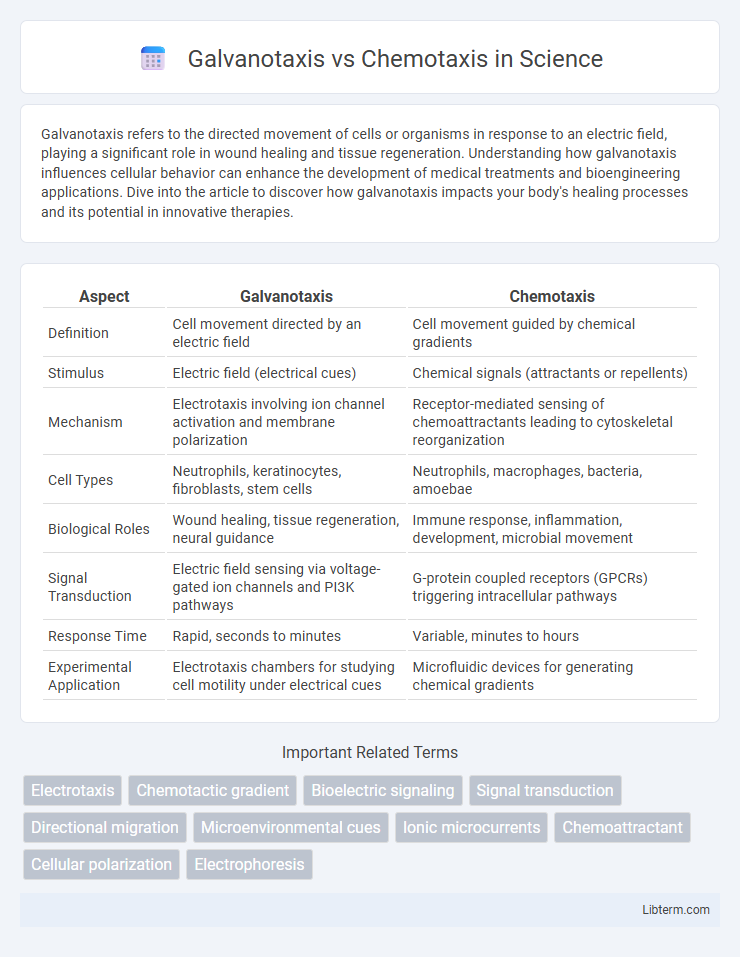Galvanotaxis refers to the directed movement of cells or organisms in response to an electric field, playing a significant role in wound healing and tissue regeneration. Understanding how galvanotaxis influences cellular behavior can enhance the development of medical treatments and bioengineering applications. Dive into the article to discover how galvanotaxis impacts your body's healing processes and its potential in innovative therapies.
Table of Comparison
| Aspect | Galvanotaxis | Chemotaxis |
|---|---|---|
| Definition | Cell movement directed by an electric field | Cell movement guided by chemical gradients |
| Stimulus | Electric field (electrical cues) | Chemical signals (attractants or repellents) |
| Mechanism | Electrotaxis involving ion channel activation and membrane polarization | Receptor-mediated sensing of chemoattractants leading to cytoskeletal reorganization |
| Cell Types | Neutrophils, keratinocytes, fibroblasts, stem cells | Neutrophils, macrophages, bacteria, amoebae |
| Biological Roles | Wound healing, tissue regeneration, neural guidance | Immune response, inflammation, development, microbial movement |
| Signal Transduction | Electric field sensing via voltage-gated ion channels and PI3K pathways | G-protein coupled receptors (GPCRs) triggering intracellular pathways |
| Response Time | Rapid, seconds to minutes | Variable, minutes to hours |
| Experimental Application | Electrotaxis chambers for studying cell motility under electrical cues | Microfluidic devices for generating chemical gradients |
Introduction to Galvanotaxis and Chemotaxis
Galvanotaxis refers to the directed movement of cells or organisms in response to an electric field, while chemotaxis describes movement guided by chemical gradients. Both processes are essential for cellular navigation during wound healing, immune responses, and development. Understanding the mechanisms behind galvanotaxis and chemotaxis provides insights into cell migration and signal transduction pathways.
Defining Galvanotaxis: Movement via Electric Fields
Galvanotaxis refers to the directed movement of cells or organisms in response to an electric field, a phenomenon crucial in processes such as wound healing and nerve regeneration. Unlike chemotaxis, which involves migration guided by chemical gradients, galvanotaxis relies on the spatial orientation of endogenous or externally applied electric fields to influence cellular polarity and motility. Key molecular mechanisms underlying galvanotaxis include the redistribution of membrane proteins, ion channel activation, and cytoskeletal reorganization, enabling cells to detect and migrate toward the cathode or anode depending on cell type.
Understanding Chemotaxis: Movement Guided by Chemical Gradients
Chemotaxis is the directed movement of cells or organisms toward higher concentrations of specific chemical signals, essential for processes like immune response and tissue repair. This mechanism relies on cell surface receptors detecting chemical gradients, triggering intracellular signaling pathways that reorganize the cytoskeleton to enable directed motility. Understanding chemotaxis provides critical insights into cellular navigation and has implications for developing targeted therapies in cancer metastasis and wound healing.
Cellular Mechanisms Underlying Galvanotaxis
Galvanotaxis involves directed cell movement in response to an electric field, with cellular mechanisms centered on the polarization of membrane receptors and redistribution of signaling molecules like PI3K and PTEN. Voltage-gated ion channels regulate intracellular calcium levels, modulating cytoskeletal rearrangements through actin polymerization and focal adhesion dynamics. This contrasts with chemotaxis, where cells navigate chemical gradients primarily via receptor-ligand binding and downstream G-protein coupled signaling pathways.
Molecular Pathways Driving Chemotaxis
Chemotaxis is primarily driven by molecular pathways involving G-protein coupled receptors (GPCRs) that detect chemical gradients, activating intracellular signaling cascades such as phosphoinositide 3-kinase (PI3K) and small GTPases like Rac and Rho to regulate actin cytoskeleton remodeling. These signaling pathways generate polarized cell migration toward chemoattractants by promoting localized actin polymerization at the leading edge and adhesion dynamics. In contrast, galvanotaxis relies on the electrophoretic redistribution of membrane proteins and ion fluxes that modulate signaling pathways distinct from the canonical chemotactic receptors.
Biological Significance of Galvanotaxis
Galvanotaxis plays a critical role in wound healing by guiding cell migration through endogenous electric fields, influencing processes such as epithelial cell migration and nerve regeneration. Unlike chemotaxis, which relies on chemical gradients to direct cellular movement, galvanotaxis utilizes bioelectric signals that are fundamental in development and tissue repair. The precise control of cell orientation and migration through electrical cues highlights its importance in developmental biology and regenerative medicine.
Physiological Roles of Chemotaxis
Chemotaxis plays a critical role in immune system function by guiding leukocytes to sites of infection or injury through gradients of chemokines and other signaling molecules. It also facilitates tissue repair and wound healing by directing fibroblasts and endothelial cells to damaged areas, promoting regeneration. In contrast, galvanotaxis primarily influences cell migration in response to electric fields, which is less prominent in physiological processes compared to chemotaxis-driven mechanisms.
Comparing Signal Detection: Electrical vs Chemical Cues
Galvanotaxis relies on detecting electrical cues through voltage-gated ion channels and membrane potential changes, enabling cells to sense and migrate along electric fields. Chemotaxis uses receptors on the cell surface to bind specific chemical ligands, triggering intracellular signaling cascades that guide directional movement toward concentration gradients. While galvanotaxis involves direct electrical gradient detection affecting cell polarity, chemotaxis depends on molecular recognition and gradient sensing of soluble attractants or repellents.
Applications of Galvanotaxis and Chemotaxis in Medicine and Research
Galvanotaxis and chemotaxis play crucial roles in guiding cell migration during wound healing, tissue regeneration, and cancer metastasis studies. Galvanotaxis applications include directing neural stem cell growth in nerve repair and enhancing keratinocyte migration for improved skin wound closure. Chemotaxis is widely used to study immune cell response in inflammation, tumor microenvironment analysis, and targeted drug delivery by harnessing chemokine gradients.
Future Perspectives: Integrating Galvanotactic and Chemotactic Studies
Future research in cell migration emphasizes integrating galvanotaxis and chemotaxis to uncover synergistic mechanisms guiding cellular movement in complex microenvironments. Advanced bioengineering platforms combining electric field stimulation with chemical gradient modulation aim to enhance tissue regeneration and targeted cancer therapies. Multidisciplinary approaches leveraging real-time imaging and computational modeling will accelerate the development of hybrid strategies for precise control of cell migration dynamics.
Galvanotaxis Infographic

 libterm.com
libterm.com